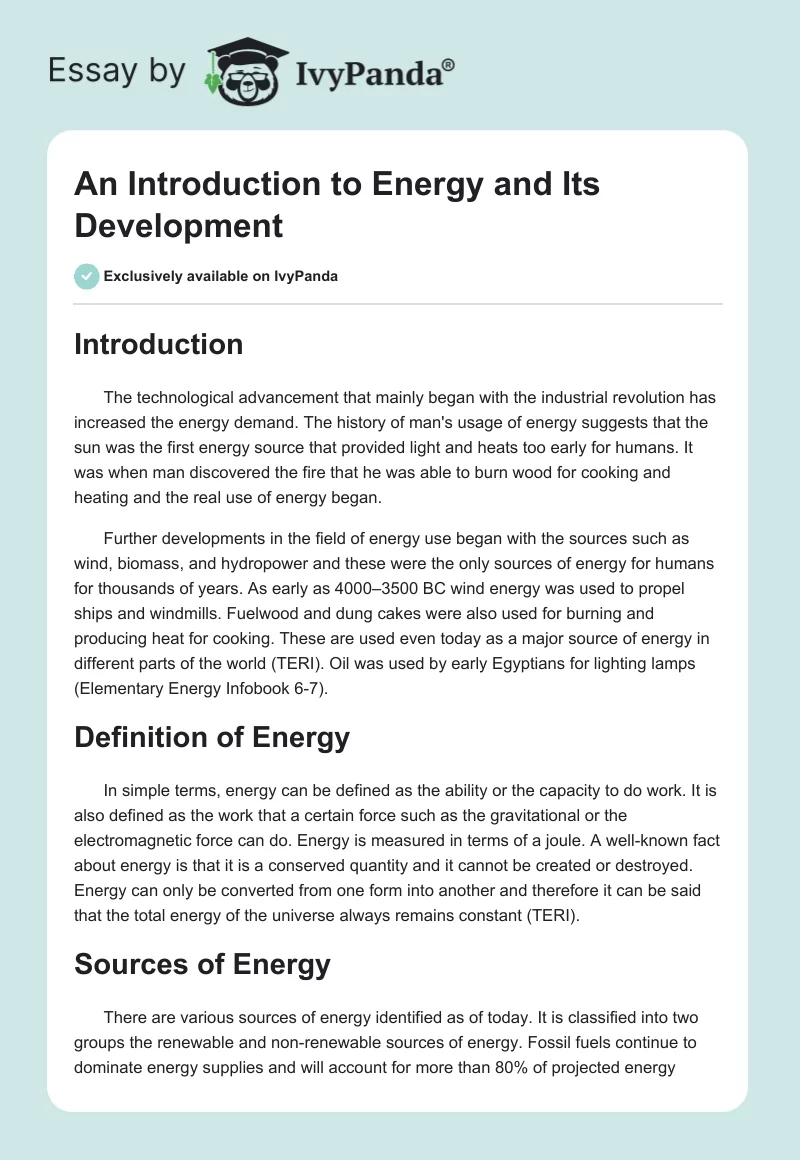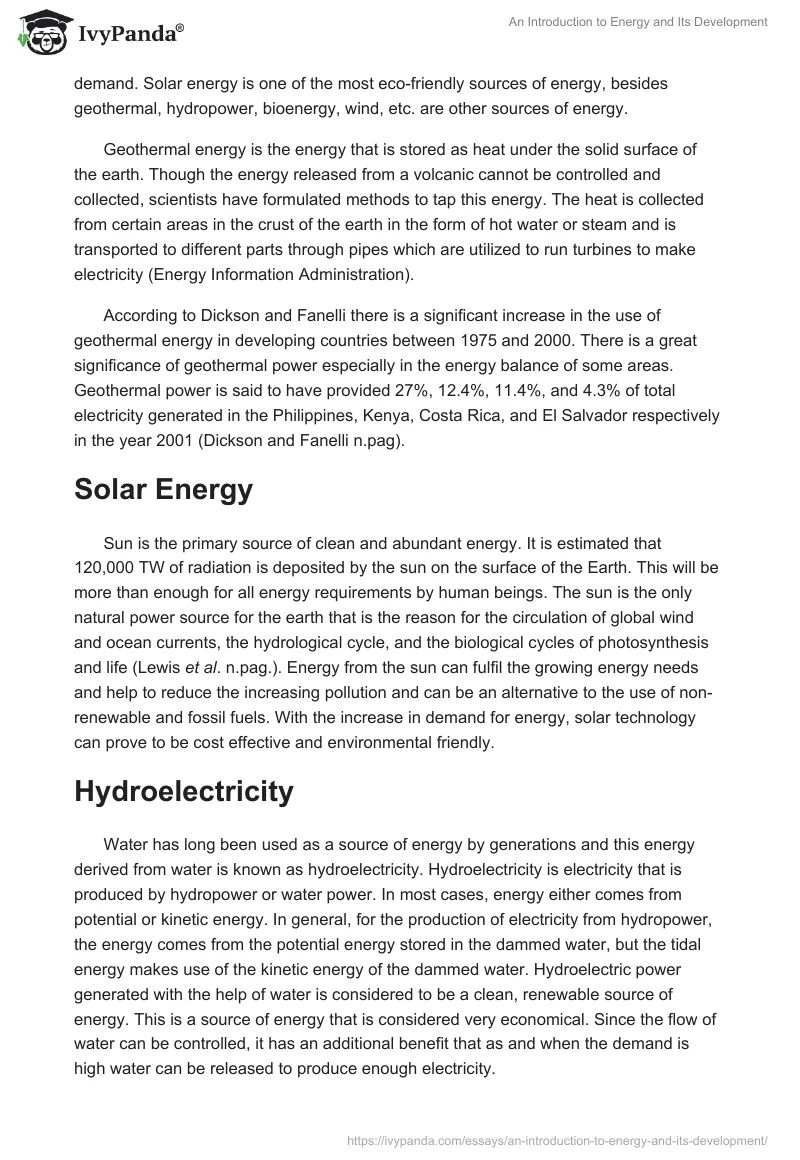Introduction
The technological advancement that mainly began with the industrial revolution has increased the energy demand. The history of man’s usage of energy suggests that the sun was the first energy source that provided light and heats too early for humans. It was when man discovered the fire that he was able to burn wood for cooking and heating and the real use of energy began.
Further developments in the field of energy use began with the sources such as wind, biomass, and hydropower and these were the only sources of energy for humans for thousands of years. As early as 4000–3500 BC wind energy was used to propel ships and windmills. Fuelwood and dung cakes were also used for burning and producing heat for cooking. These are used even today as a major source of energy in different parts of the world (TERI). Oil was used by early Egyptians for lighting lamps (Elementary Energy Infobook 6-7).
Definition of Energy
In simple terms, energy can be defined as the ability or the capacity to do work. It is also defined as the work that a certain force such as the gravitational or the electromagnetic force can do. Energy is measured in terms of a joule. A well-known fact about energy is that it is a conserved quantity and it cannot be created or destroyed. Energy can only be converted from one form into another and therefore it can be said that the total energy of the universe always remains constant (TERI).
Sources of Energy
There are various sources of energy identified as of today. It is classified into two groups the renewable and non-renewable sources of energy. Fossil fuels continue to dominate energy supplies and will account for more than 80% of projected energy demand. Solar energy is one of the most eco-friendly sources of energy, besides geothermal, hydropower, bioenergy, wind, etc. are other sources of energy.
Geothermal energy is the energy that is stored as heat under the solid surface of the earth. Though the energy released from a volcanic cannot be controlled and collected, scientists have formulated methods to tap this energy. The heat is collected from certain areas in the crust of the earth in the form of hot water or steam and is transported to different parts through pipes which are utilized to run turbines to make electricity (Energy Information Administration).
According to Dickson and Fanelli there is a significant increase in the use of geothermal energy in developing countries between 1975 and 2000. There is a great significance of geothermal power especially in the energy balance of some areas. Geothermal power is said to have provided 27%, 12.4%, 11.4%, and 4.3% of total electricity generated in the Philippines, Kenya, Costa Rica, and El Salvador respectively in the year 2001 (Dickson and Fanelli n.pag).
Solar Energy
Sun is the primary source of clean and abundant energy. It is estimated that 120,000 TW of radiation is deposited by the sun on the surface of the Earth. This will be more than enough for all energy requirements by human beings. The sun is the only natural power source for the earth that is the reason for the circulation of global wind and ocean currents, the hydrological cycle, and the biological cycles of photosynthesis and life (Lewis et al. n.pag.). Energy from the sun can fulfil the growing energy needs and help to reduce the increasing pollution and can be an alternative to the use of non-renewable and fossil fuels. With the increase in demand for energy, solar technology can prove to be cost effective and environmental friendly.
Hydroelectricity
Water has long been used as a source of energy by generations and this energy derived from water is known as hydroelectricity. Hydroelectricity is electricity that is produced by hydropower or water power. In most cases, energy either comes from potential or kinetic energy. In general, for the production of electricity from hydropower, the energy comes from the potential energy stored in the dammed water, but the tidal energy makes use of the kinetic energy of the dammed water. Hydroelectric power generated with the help of water is considered to be a clean, renewable source of energy. This is a source of energy that is considered very economical. Since the flow of water can be controlled, it has an additional benefit that as and when the demand is high water can be released to produce enough electricity.
Bioenergy
Bioenergy as the word indicates is the energy derived from biomass. It is an inclusive term for all forms of biomass and biofuels. Human beings have developed techniques to convert the organic material, especially derived from the plants as fuel and the energy produced as a result of this is termed bioenergy. The organic material burned to produce bioenergy is termed biomass (U.S. Department of Energy). Biomass is potentially a renewable resource of energy when compared to most other sources of energy. The scientific world has found that bioenergy sources could be a replacement for the decreasing non-renewable energy sources (Science encyclopaedia).
Fossil Fuels
These are some of the major sources of energy in the world. It is estimated that fossil fuels will continue to dominate as a source of energy until 2030. However, since these are derived from prehistoric fossils, they are limited in quantity. Coal, oil and natural gas are the main sources of fossil fuel (Energy Story). Coal is a major source of energy and it is burned to heat homes and run electrical machinery. Even today we are dependent on about 20 per cent of energy coming from coal and about 45 % is from oil. Besides fuels such as LPG (Liquid Petroleum Gas) form a major source of cooking in developing countries. Natural gas is another important source of energy that accounts for about 25 per cent of the energy.
There are other forms of energy such as wind energy and nuclear energy. Wind energy is an important natural source of energy used for various purposes. These are also non-polluting. Winds can be used to turn windmills, which in turn can generate electricity.
Development of Energy
Geothermal energy is utilized in many ways which include thermal waters piped directly from the ground. Recovering Earth’s heat at high temperatures and rates is a challenge of daunting complexity in the absence of a natural hydrothermal system. There is enormous potential to increase the accessibility of geothermal energy for future generations (Hulen and Wright n.pag).
Technological innovations in the field of solar energy make it more users friendly and economic. The thermonuclear process occurring in the sun is responsible for creating energy (Brown n.pag). There are three basic steps involved in all routes for utilizing solar energy and they are capture, conversion, and storage (Lewis et al. n.pag).
Bioenergy technologies use renewable biomass resources, and its use has been comparatively high in the United States and it ranks second only to hydropower in renewable U.S. primary energy production (U.S. Department of Energy).
Hydroelectricity is the production of electricity by hydraulic turbines. These turbines rotate due to moving water as it flows from a higher to lower elevation. The distance or the height from which the waterfalls are on the turbines is what creates the water pressure and, along with the volume of water, decides the amount of electricity generated. This is a sustainable method as energy is not wasted.
Conclusion
The negative environmental impacts especially of the inefficient uses of energy are a major problem in the world. Though there is enough awareness among people and several steps taken for conservation of energy, the over-dependence on certain sources such as fossil fuels are creating pressure on the resource base of earth. There is a need for efficient use of various energy sources and at the same time reduce the emission of harmful pollutants.
Work Cited
Brown, E.W. An Introduction to Solar Energy, (1988). Web.
Dickson, M.H. and Fanelli, M. What is Geothermal Energy? (2004). Web.
Elementary Energy Infobook, History of Energy. The Need Project, Manassas, pp 6-7. 2009. Web.
Energy Information Administration (EIA), Energy Kid’s Page Official energy statistics from U.S. Government. 2009. Web.
Energy Story, Chapter 8: Fossil Fuels – Coal, Oil and Natural Gas, In The Energy Story, (2002). Web.
Hulen, J.B. and Wright, P.M. Geothermal energy: Clean, Sustainable energy for the benefit of humanity and the environment. (2001) Published by Energy & Geoscience Institute, University of Utah.
Lewis, N.S. et al. Report on the Basic Energy Sciences Workshop on Solar Energy Utilization, (2005). Web.
Science encyclopaedia, Bioenergy – Primary ways of using bioenergy, Sources of biomass, Advantages and disadvantages of bioenergy, (2009). Web.
TERI, Energy. EduGreen. 2009. Web.
U.S. Department of Energy, Bioenergy, 2009. Web.


